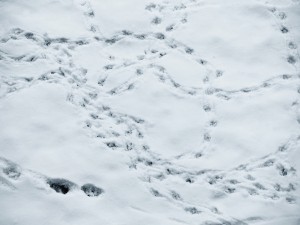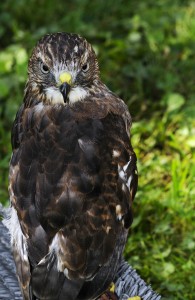My ongoing tracery of Thoreau’s winter of 1854 has carried me to this short-long month in the season’s belly. Like our current winter, 1854’s featured some wild swings – from thaw to freeze, with one morning reading of -19 degrees, from long blue horizons to thick snows, and from walking the winding river to trailing along reading’s lines. And early February of ’54 also contained detailed entries about Thoreau’s gleanings from one Ephraim Jones’ hundred-year-old ledgers, a record of Concord’s wilder days when farmers and hunters still traded wildcat pelts, among other items. Thoreau read and recorded from these ledgers avidly.
As I’ve read through his days, (I’m now some two weeks behind the rush of our current year; I am in no hurry), I’ve noticed how readily Thoreau shifts from the findings of his daily walks to those from his daily readings. A mink’s prints along the riverbank lead to words drawn from Varro…and those words lead back out into the woods where a rabbit’s curious pauses suggest that he may have “whirled around.” Even as he walks abroad, Thoreau burrows into and pulls up lives from the past in these books and ledgers: “Hezekiah Stratton has credit in 1743, ‘Feb. 7 by 1/2 a Catt skin 0-1-4 1/2,’ of course a wildcat.”
“Of course a wildcat.” What, I wonder, does it take to bring a wildcat to life from an old ledger? What quality of imagination finds life equally in a line of prints and the print of a line?
“Howitt says that in Britain ‘the law is opposed to tracking game in a snow.’ I feel some pity for the wild animals when I see how their tracks betray them in calm weather after a snowstorm, and consider what risks they run of being exterminated.
Is not January alone pure winter? December belongs to the fall; is a wintry November: February to the spring; it is a snowy March.
The water was several inches deep in the road last evening, but it has run nearly dry by morning. The illustrious farmer Romans who lived simply on their land, to whom Columella refers are Q. Cincinnatus, C. Fabricius, and Curius Dentatus.” Journal, 2/9/54
Wild animals, thaws and snows, Roman farmers – they are all alive together in the terrain of this mind whose tracks line the page before me; this afternoon, I will go look to see what has passed along the river before the next storm blows in.
What are you seeing and reading, these winter days? Who’s alive in your mind?




